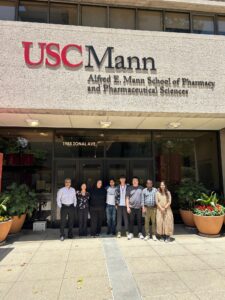4‑Substituted-2-Thiazole Amides as Viral Replication Inhibitors of Alphaviruses.
J. Med. Chem. 2024, Article ASAP
Garzan, A.; Ahmed, S.K.; Haese, N.N.; Sulgey, G.; Medica, S.; Smith, J.L.; Zhang, S.; Ahmad, F.; Karyakarte, S.; Lynn Rasmussen, Filippis, V.D.; Tekwani, B.; Bostwick, R.; Suto, M.J.; Hirsch, A.J.; Morrison, T.E.; Heise, M.T.; Augelli-Szafran, C. E.; Streblow, D.N.; Pathak, A.K.; Chafiq, O.M.
2-(Methylthio)-N-(4-(naphthalen-2-yl)thiazol-2-yl)nicotinamide 1 was identified as an inhibitor against Chikungunya
virus (CHIKV) with good antiviral activity [EC50 = 0.6 μM; EC90 = 0.93 μM and viral titer reduction (VTR) of 6.9 logs at 10
μM concentration] with no observed cytotoxicity (CC50 = 132 μM) in normal human dermal fibroblast (NHDF) cells. Structure−
activity relationship (SAR) studies to further improve the potency, efficacy, and drug-like properties of 1 led to the discovery of a
new potent inhibitor N-(4-(3-((4-cyanophenyl)amino)phenyl)thiazol-2-yl)-2-(methylthio)nicotinamide 26, which showed a VTR of
8.7 logs at 10 μM against CHIKV and an EC90 of 0.45 μM with considerably improved MLM stability (t1/2 = 74 min) as compared
to 1. Mechanism of action studies show that 26 inhibits alphavirus replication by blocking subgenomic viral RNA translation and
structural protein synthesis. The in vivo efficacy studies of compound 26 on CHIKV infection in mice are reported.
Read More
Novel Epigallocatechin Gallate (EGCG) Analogs with Improved Biochemical Properties for Targeting Extracellular and Intracellular Staphylococcus aureus
Appl. Microbiol. 2024, 4, 1568–1581
Grosso, R.; Nguyen, V.; Ahmed, S.K.; Wong-Beringer. A
Staphylococcus aureus is a leading cause of bloodstream infection (SAB), with up to 30%
mortality. Despite treatment with standard antibiotics, one in three patients develops a persistent
infection, which portends a five-fold increase in the risk of death. Persistent SAB has been attributed
in part to the inability of antistaphylococcal antibiotics to eradicate intracellular S. aureus surviving
inside macrophages. (-)- Epigallocatechin gallate (EGCG) is a catechin found in green tea that has
been widely studied for its broad biological activities, ranging from anticancer to antibacterial activity.
However, EGCG is greatly limited by its poor drug-like properties in terms of stability, membrane
permeability, and bioavailability. In this study, we established through a series of in vitro experiments
that structural modifications of EGCG enhanced drug-like properties while maintaining or improving
its antistaphylococcal activity. Our lead EGCG analogs (MCC-1 and MCC-2) showed improved
biochemical properties along with increased potency against extracellular S. aureus and restored
susceptibility of β-lactam agents to methicillin-resistant S. aureus (MRSA). Importantly, the lead
analogs but not EGCG potentiated macrophage- and antibiotic-mediated clearance of intracellular
bacteria. Overall, EGCG analogs showed promise for further development as adjunctive therapy
candidates for the treatment of SAB.
Read More
Targeting Chikungunya Virus Replication by Benzoannulene Inhibitors
J. Med. Chem. 2021, 64(8), 4762–4786
Ahmed, S.K.; Haese, N.N.; Cowan, J. T.; Pathak, V.; Chafiq, O. M; Smith, V. J.; Rodzinak, K. J.; Ahmad, F.; Zhang, S.; Bonin, K. M.; Streblow, A. D.; Streblow, C. E.; Kreklywich, C. N.; Morrison, C.; Sarkar, S.; Moorman, N.; Sander, W.; Allen, R.; DeFilippis, V.; Tekwani, B. L.; Wu, M.; Hirsch, A. J.; Smith, J. L.; Tower, N. A.; Rasmussen, L.; Bostwick, R.; Maddry, J. A.; Ananthan, S.; Gerdes, J. M.; Augelli-Szafran, C. E.; Suto, M. J.; Morrison, T. E.; Heise, M. T.; Streblow, D. N.; Ashish K. Pathak, A. K
A benzo[6]annulene, 4-(tert-butyl)-N-(3-methoxy-5,6,7,8-tetrahydronaphthalen-2-yl) benzamide (1a), was identified as an inhibitor against Chikungunya virus (CHIKV) with antiviral activity EC90 = 1.45 μM and viral titer reduction (VTR) of 2.5 log at 10 μM with no observed cytotoxicity (CC50 = 169 μM) in normal human dermal fibroblast cells. Chemistry efforts to improve potency, efficacy, and drug-like properties of 1a resulted in a novel lead compound 8q, which possessed excellent cellular antiviral activity (EC90 = 270 nM and VTR of 4.5 log at 10 μM) and improved liver microsomal stability. CHIKV resistance to an analog of 1a, compound 1c, tracked to a mutation in the nsP3 macrodomain. Further mechanism of action studies showed compounds working through inhibition of human dihydroorotate dehydrogenase in addition to CHIKV nsP3 macrodomain. Moderate efficacy was observed in an in vivo CHIKV challenge mouse model for compound 8q as viral replication was rescued from the pyrimidine salvage pathway
Read More
Synthesis and anti-acetylcholinesterase properties of novel β- and γ-substituted alkoxy organophosphonates
Bioorg Med Chem Lett . 2013;23(7):2048-51
Ahmed, S. K.; Belabassi, Y.; Sankaranarayanan, L.; Chao, C. K.; Gerdes, J. M.; Thompson, C. M.
Activated organophosphate (OP) insecticides and chemical agents inhibit acetylcholinesterase (AChE) to form OP-AChE adducts. Whereas the structure of the OP correlates with the rate of inhibition, the structure of the OP-AChE adduct influences the rate at which post-inhibitory reactivation or aging phenomena occurs. In this report, we prepared a panel of β-substituted ethoxy and γ-substituted propoxy phosphonoesters of the type p-NO(2)PhO-P(X)(R)[(O(CH(2))(n)Z] (R=Me, Et; X=O, S; n=2, 3; Z=halogen, OTs) and examined the inhibition of three AChEs by select structures in the panel. The β-fluoroethoxy methylphosphonate analog (R=Me, Z=F, n=2) was the most potent anti-AChE compound comparable (ki ∼6 × 10(6)M(-1)min(-1)) to paraoxon against EEAChE. Analogs with Z=Br, I, or OTs were weak inhibitors of the AChEs, and methyl phosphonates (R=Me) were more potent than the corresponding ethyl phosphonates (R=Et). As expected, analogs with a thionate linkage (PS) were poor inhibitors of the AChEs.
Read More
Use of the hydantoin isostere to produce inhibitors showing selectivity toward the vesicular glutamate transporter versus the obligate exchange transporter system x(c)(-)
Bioorg Med Chem Lett . 2011 ;21(14):4358-62
Ahmed, S. K.; Etoga, J. L. G.; Patel, S. A.; Bridges, R. J.; Thompson, C. M
Evidence was acquired prior to suggest that the vesicular glutamate transporter (VGLUT) but not other glutamate transporters were inhibited by structures containing a weakly basic α-amino group. To test this hypothesis, a series of analogs using a hydantoin (pK(a)∼9.1) isostere were synthesized and analyzed as inhibitors of VGLUT and the obligate cystine-glutamate transporter (system x(c)(-)). Of the hydantoin analogs tested, a thiophene-5-carboxaldehyde analog 2l and a bis-hydantoin 4b were relatively strong inhibitors of VGLUT reducing uptake to less than 6% of control at 5mM but few inhibited system x(c)(-) greater than 50% of control. The benzene-2,4-disulfonic acid analog 2b and p-diaminobenzene analog 2e were also good hydantoin-based inhibitors of VGLUT reducing uptake by 11% and 23% of control, respectively, but neither analog was effective as a system x(c)(-) inhibitor. In sum, a hydantoin isostere adds the requisite chemical properties needed to produce selective inhibitors of VGLUT.
Read More
A novel fluorine-18 β-fluoroethoxy organophosphate positron emission tomography imaging tracer targeted to central nervous system acetylcholinesterase
ACS Chem Neurosci . 2014 ;5(7):519-24
Shelly, J.; Ahmed, S.K.; Stephanie, M.; Braden, M.; Belabassi, Y.; VanBrocklin, H.; Thompson, C.; Gerdes, J
Radiosynthesis of a fluorine-18 labeled organophosphate (OP) inhibitor of acetylcholinesterase (AChE) and subsequent positron emission tomography (PET) imaging using the tracer in the rat central nervous system are reported. The tracer structure, which contains a novel β-fluoroethoxy phosphoester moiety, was designed as an insecticide-chemical nerve agent hybrid to optimize handling and the desired target reactivity. Radiosynthesis of the β-fluoroethoxy tracer is described that utilizes a [(18)F]prosthetic group coupling approach. The imaging utility of the [(18)F]tracer is demonstrated in vivo within rats by the evaluation of its brain penetration and cerebral distribution qualities in the absence and presence of a challenge agent. The tracer effectively penetrates brain and localizes to cerebral regions known to correlate with the expression of the AChE target. Brain pharmacokinetic properties of the tracer are consistent with the formation of an OP-adducted acetylcholinesterase containing the fluoroethoxy tracer group. Based on the initial favorable in vivo qualities found in rat, additional [(18)F]tracer studies are ongoing to exploit the technology to dynamically probe organophosphate mechanisms of action in mammalian live tissues.
Read More
Conformationally-restricted amino acid analogues bearing a distal sulfonic acid show selective inhibition of system x(c)(-) over the vesicular glutamate transporter
Bioorg Med Chem Lett . 2010 ;20(8):2680-3
Etoga, J. L. E.; Ahmed, S. K.; Patel, S.; Bridges, R. J.; Thompson. C. M.
A panel of amino acid analogs and conformationally-restricted amino acids bearing a sulfonic acid were synthesized and tested for their ability to preferentially inhibit the obligate cysteine-glutamate transporter system x(c)(-) versus the vesicular glutamate transporter (VGLUT). Several promising candidate molecules were identified: R/S-4-[4'-carboxyphenyl]-phenylglycine, a biphenyl substituted analog of 4-carboxyphenylglycine and 2-thiopheneglycine-5-sulfonic acid both of which reduced glutamate uptake at system x(c)(-) by 70-75% while having modest to no effect on glutamate uptake at VGLUT.
Read More



